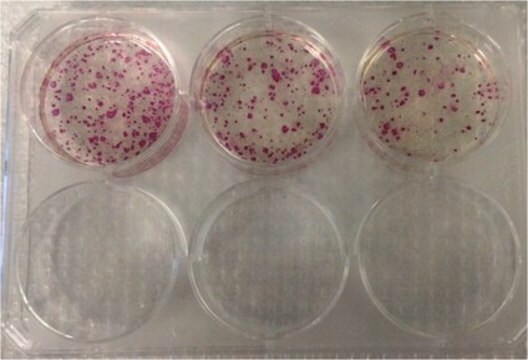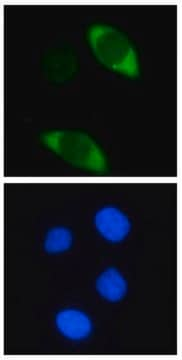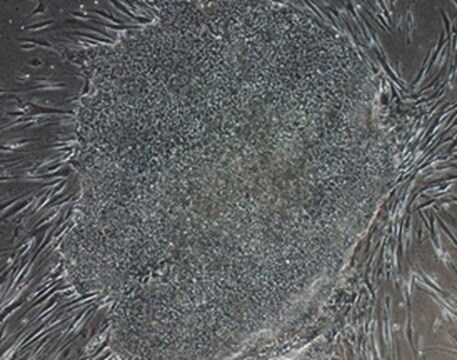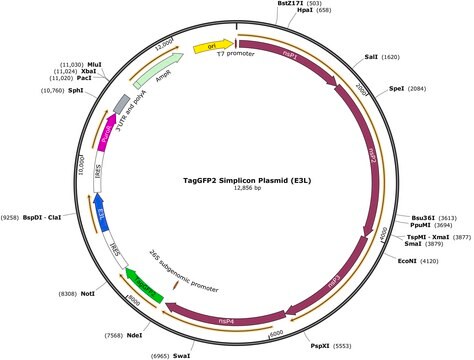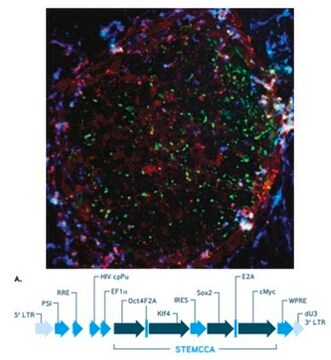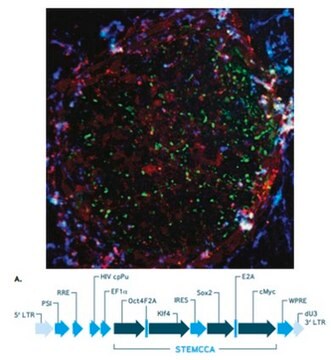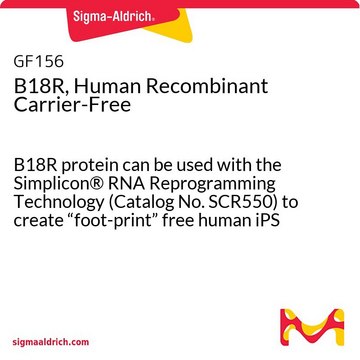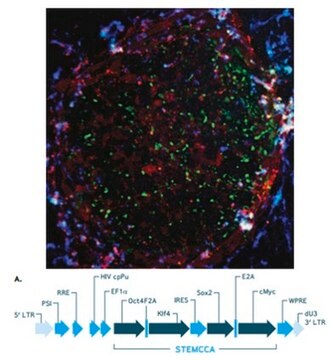SCR549
Simplicon Reprogramming RNA (OKSG)
Iniciar sesiónpara Ver la Fijación de precios por contrato y de la organización
About This Item
UNSPSC Code:
12161503
eCl@ss:
32161000
NACRES:
NA.32
Productos recomendados
description
Induced Pluripotent Stem Cells
Quality Level
technique(s)
cell culture | stem cell: suitable
General description
Various methods utilizing viruses, DNA, RNA, miRNA and protein have been developed to generate integration-free induced pluripotent stem cells (iPSCs). Disadvantages to existing methods include: (1) low reprogramming efficiency (i.e. DNA and protein), (2) a lengthy requirement for negative selection and subcloing steps to remove persistent traces of the virus (i.e. Sendai virus)1 and (3) for daily transfections of four individual in vitro generated mRNAs over a 14 day period (i.e. mRNA based)2.
EMD Millipore′s Simplicon RNA Reprogramming Kit (OKSG) is a safe and efficient method to generate integration free, virus-free human iPS cell using a single transfection step. The technology is based upon a positive strand, single-stranded RNA species derived from non-infectious (non-packaging), self-replicating Venezuelian equine encephalitis (VEE) virus3. The Simplicon RNA replicon is a synthetic in vitro transcribed RNA expressing all four reprogramming factors (OKS-iG; Oct4, Klf4, Sox2 and Glis1) in a polycistronic transcript that is able to self-replicate for a limited number of cell divisions.
EMD Millipore′s Simplicon RNA Reprogramming Kit (OKSG) is a safe and efficient method to generate integration free, virus-free human iPS cell using a single transfection step. The technology is based upon a positive strand, single-stranded RNA species derived from non-infectious (non-packaging), self-replicating Venezuelian equine encephalitis (VEE) virus3. The Simplicon RNA replicon is a synthetic in vitro transcribed RNA expressing all four reprogramming factors (OKS-iG; Oct4, Klf4, Sox2 and Glis1) in a polycistronic transcript that is able to self-replicate for a limited number of cell divisions.
Application
Advantages of the TM=["SIMPLICON"] RNA Reprogramming Kit:
- Integration-free, footprint-free iPS cells. No risk of genomic integration
- Safe, virus free, synthetic polycistronic RNA replicon (all four reprogramming factors in 1 RNA strand)
- Only 1-day transfection required. The RNA replicon is able to self-replicate, elliminating the need for laborious daily transfection of multiple individual mRNAs over a 14 day period.
- Efficient and rapid reprogramming.
- No screening required to ensure viral remnants are not present.
- Controlled elimination of synthetic RNA replicon by removal of B18R protein.
- Validated for reprogramming in feeder-based and feeder-free culture conditions.
Components
1. VEE-OKS-iG RNA: (Part No. CS210583) One (1) vial containing 10 µL of RNA (1 ug/uL). Store at -80°C. 2. B18R-E3L RNA: (Part No. CS224516) One (1) vial containing 10 µL of RNA (1 µg/µL). Store at -80°C.
Quality
Tested to confirm the generation of iPS cells from p6 human foreskin fibroblasts. Other cell types have not been tested and thus similar results can not be guaranteed.
Storage and Stability
VEE-OKS-iG and B18R RNAs: Stable for 4 months from date of receipt when stored appropriately at -80°C. For best recovery, quick-spin the vial prior to opening. Thaw on ice. While on ice, aliquot into sterile, nuclease-free Eppendorf® tubes and store at -80°C. Limit repeated freeze-thaw cycles. Use in a sterile RNAse-free environment.
Legal Information
Eppendorf is a registered trademark of Eppendorf AG
Disclaimer
Unless otherwise stated in our catalog or other company documentation accompanying the product(s), our products are intended for research use only and are not to be used for any other purpose, which includes but is not limited to, unauthorized commercial uses, in vitro diagnostic uses, ex vivo or in vivo therapeutic uses or any type of consumption or application to humans or animals.
Storage Class
12 - Non Combustible Liquids
flash_point_f
Not applicable
flash_point_c
Not applicable
Certificados de análisis (COA)
Busque Certificados de análisis (COA) introduciendo el número de lote del producto. Los números de lote se encuentran en la etiqueta del producto después de las palabras «Lot» o «Batch»
¿Ya tiene este producto?
Encuentre la documentación para los productos que ha comprado recientemente en la Biblioteca de documentos.
Nuestro equipo de científicos tiene experiencia en todas las áreas de investigación: Ciencias de la vida, Ciencia de los materiales, Síntesis química, Cromatografía, Analítica y muchas otras.
Póngase en contacto con el Servicio técnico